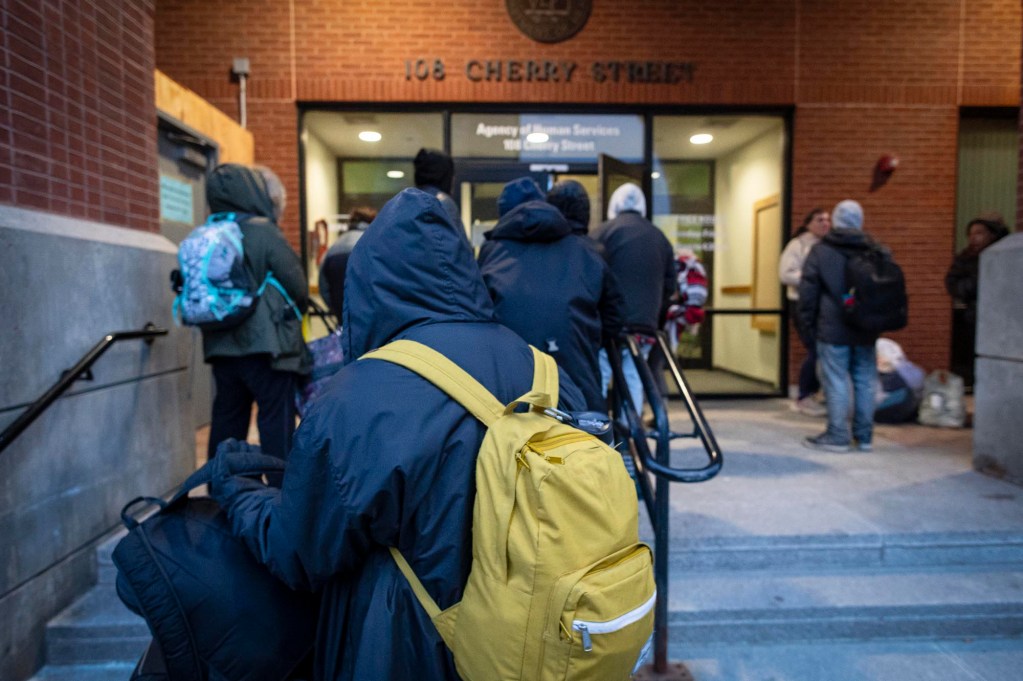People who are unhoused line up to be admitted to a temporary shelter in Burlington on March 18, 2024. File photo by Glenn Russell/VTDigger
This story, by Report for America corps member Carly Berlin, was produced through a partnership between VTDigger and Vermont Public.
The number of unhoused Vermonters living without shelter jumped last year, while the overall number of people experiencing homelessness has continued to climb amid an acute housing shortage.
Those are the results of the 2024 point-in-time count, an annual, federally-mandated effort to tally every person experiencing homelessness on a single night each January.
Statewide, this year’s census recorded 3,458 people experiencing homelessness, a nearly 5% increase over the number tallied in January 2023. That’s according to an analysis of this year’s data published Monday by the Housing and Homelessness Alliance of Vermont and the two organizations that oversee the count, one based in Chittenden County and the other capturing the rest of the state.
“Vermont continues to register record levels of homelessness,” Anne Sosin, a public health researcher at Dartmouth College who studies homelessness, said of the report’s findings. “This is unsurprising, given that homelessness is fundamentally a housing problem – and Vermont continues to face a large shortage of adequate, affordable housing.”
The year-over-year rise in homelessness recorded in the 2024 count is more modest than those of recent years.
It’s widely believed that the state’s expansion of the motel shelter program during the Covid-19 pandemic contributed to the massive increase in unhoused people counted in 2021: Because more people were in shelter, they were easier to count. To some, including Sosin, the 2021 tally gave the state a more accurate count of people experiencing homelessness than it had ever had.
But even as state leaders have scaled back the pandemic-era expansion of the motel program – and unhoused people have become more scattered – the state’s overall count of people experiencing homelessness has continued to tick up.
And as the state’s safety-net motel program has shrunk, more Vermonters appear to be unsheltered. Following a major round of motel program evictions last summer, January’s count registered a significant rise in the number of Vermonters living without shelter. The count captured 166 unsheltered people, which the U.S. Department of Housing and Urban Development defines as having a “primary nighttime location” like a vehicle or the streets. That’s up from 137 people in January 2023.
“To see that increase in that particular moment in time really speaks to the inadequacy of our shelter capacity in the state – in the depths of winter,” Sosin said, noting that statewide shelter capacity is typically at its largest during the coldest months of the year.
The report’s authors note that the count’s findings are almost certainly an undercount. Accurately counting people who are unsheltered is notoriously difficult. In a rural state like Vermont, service providers often lack the resources to fan out to remote corners where people might be staying, and the count only registers people who engaged with outreach workers conducting the January tally.
During this year’s tally, for example, the count registered 87 people experiencing unsheltered homelessness in Chittenden County. But that same month, at day shelters in the county, 182 people self-reported that they lacked shelter, according to the report.
The challenges inherent to counting unsheltered people could also muddy the count’s overall findings, Sosin said.
“As our ability to count people gets increasingly constrained, we will likely miss more people over time, even as the crisis of homelessness continues to grow,” Sosin said. “I don’t see the decrease in the number of people newly entering into homelessness as a reflection of a change in the situation as much as a reflection of the limits of our ability to count them.”
The definition of homelessness used for the count is also fairly narrow, Sosin noted, excluding people staying with relatives or sleeping on someone’s couch.
Though far from comprehensive, the count still provides insight into who is experiencing homelessness in Vermont.
This year’s count registered a stark racial disparity in Vermont’s unhoused population, one that has been persistent in recent years. While Black people make up 1.4% of Vermont’s total population, over 8% of people who are unhoused are Black.
The number of unhoused families with children dropped slightly last year, which Sosin said likely reflects greater investment and attention to that group. Even as the count captured fewer families, though, it clocked a major uptick in the number of young people experiencing homelessness: 737 people under the age of 18 were found to be homeless at the time of the count, up from 654 last year. That’s the largest jump in any age category tallied.
People with disabilities also make up a sizable portion of the state’s unhoused population: 855 people reported having a serious mental illness, and 398 reported chronic substance abuse.
In addition to an affordable housing shortage, the report’s authors point to other factors driving the state’s housing and homelessness crisis, including rising housing costs and “a failure to provide adequate mental health and substance use services,” among others. And, with the state’s shelter capacity already strained, they note that upcoming limits to the state’s motel program, and an expected drop in housing stabilization funds, could exacerbate Vermont’s homelessness crisis this year.
The annual point-in-time count is used by state and federal officials to guide policy and funding decisions. While far from perfect, it offers some of the best comparative figures on the state of homelessness nationwide, and has formed the basis for federal reports showing that Vermont’s rates of homelessness are the second highest in the country.
Read the story on VTDigger here: Annual count shows rise in homelessness in Vermont — and a jump in those living without shelter.

